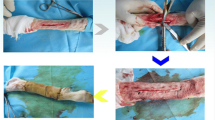Abstract
Standard X-ray techniques are used to follow up the healing process of bone fractures. However, these methods allow only indirect conclusions about the stability of the healing bone, depending on the experience of the clinician. In addition, by radiologic means, delayed union or non-union can only be diagnosed on the basis of the absence of specific changes such as callus formation. Therefore, efforts have been made to develop alternative methods for monitoring the healing process. The measuring principle of a non-invasive method is based on evaluation of changes in mechanical vibration reactions. The measuring system is composed of two sound transducers, an amplifier module and an AD converter attached to a PC. The assessment of 150 healthy individuals as well as an initial measuring series after treatment of tibial fractures with an external fixator system revealed highly significant differences between intact and fractured tibias. Thus, computerised sonometry is capable of supplying quantitatively recordable information about the stability of a fractured bone at any time in the healing process. Furthermore, this non-invasive technique allows early diagnosis of disorders in the repair process by the absence of change in the parameters.
Similar content being viewed by others
References
Cornelissen M, Van der Perre G, Martens M, Mulier JC (1984) Vibration measurements correlated with mechanical stability. Characteristics — a model with appliance to fracture healing assessment. Biomater Biomech, pp 127–132
Fellinger M, Szyszkowitz R, Passler J (1989) Die Reosteosynthese bei Versorgung von Unterschenkel-Schaftfrakturen mittels FE-Systemen — ein vermeidbarer Zweiteingriff? Acta Chirurg Austria 21(3)
Fellinger M, Schanner A, Szyszkowitz R, Leitgeb N, Stockenhuber N, Schweighofer F, Roupec R (1992) Die Analyse des mechanischen Schwingverhaltens und der akustischen Schallleitung knöcherner Strukturen als Möglichkeit zur Beurteilung der Knochenbruchheilung. Biomed Technik 37 [Suppl]:251–253
Fellinger M, Schanner A, Szyszkowitz R, Leitgeb N, Stockenhuber N, Roupec R (1992) Computerisierte Sonometrie — Die Anwendung eines nicht invasiven Verfahrens zur Stabilitätsbeurteilung nach Frakturen. Aktuel Traumatol 22
Leitgeb N, Bodenteich A, Schweighofer F, Fellinger M (1990) Sonographische Frakturdiagnostik. Ultraschall Med 11:206
Leitgeb N, Lumpi KH, Schanner A, Fellinger M (1992) Quantitative Erfassung des Frakturheilungsverlaufes. Biomed Technik 37 [Suppl 1]:231–234
Lippmann RK (1932) The use of auscultatory percussion for the examination of fractures. J Bone Joint Surg 14:118
Nokes L, Mintowt-Czyz WJ, Mackie I, Fairclough JA, Williams J (1985) Vibration analysis in the assessment of conservatively managed tibial fractures. J Biomed Eng 6:226–229
Author information
Authors and Affiliations
Rights and permissions
About this article
Cite this article
Fellinger, M., Leitgeb, N., Szyszkowitz, R. et al. Early detection of delayed union in lower leg fractures using a computerised analysis of mechanical vibration reactions of bone for assessing the state of fracture healing. Arch Orthop Trauma Surg 113, 93–96 (1994). https://doi.org/10.1007/BF00572913
Issue Date:
DOI: https://doi.org/10.1007/BF00572913




